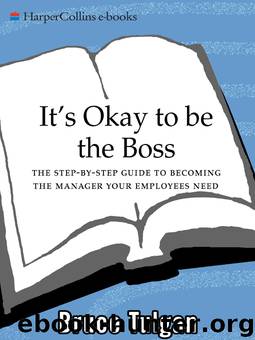It's Okay to Be the Boss by Bruce Tulgan

Author:Bruce Tulgan
Language: eng
Format: epub
Published: 2018-09-18T16:00:00+00:00
Turn best practices into standard operating procedures.
Teach standard operating procedures to everyone and require their use.
Nag, nag, nag about standard operating procedures until you sound like a broken record.
Give employees step-by-step checklists whenever possible.
Follow up, follow up, follow up.
Every Assignment Has Parameters
Some jobs actually require employees to take risks and make mistakes, such as jobs that are by nature about being creative and innovative. The whole idea is to create something new and different. In that case, how is it possible to tell employees exactly what to do and how to do it?
If an employee’s job is to be creative, the biggest favor you can do for that employee is to be clear about what is not within the employee’s discretion. Spell out the parameters within which the employee ought to operate. If you don’t want to hold the employee back in any way—no guidelines, no goals—clearly define whatever parameters can be established. Is there a time limit? Or will you pay the employee to brainstorm ad infinitum? How will you know when the employee is “done”? How will you recognize a finished product or result? If you want an employee to feel free to take risks and make mistakes, then what you need to do is spell that out as a concrete assignment: “I want you to take risks and make mistakes.” Maybe you need to tell the employee how many risks to take and how many mis takes to make. Maybe not. But you have to define parameters in order to create a space in which risk taking and mistakes are truly safe in the context of a job.
Sometimes when managers give out “creative” assignments, what’s really going on is that they don’t have a clear goal in mind; they don’t know what they are looking for…yet. So they ask an employee to “take a crack at it,” so they will have something to look at and can take it from there. This is nothing more than a manager using an employee to work out the early stages of his or her creative process. But if the manager has not explained to the employee what her role in the assignment is, it can turn into a frustrating experience. The employee works hard on a project, only to have her manager send it back to the drawing board over and over or take over entirely to rework it himself. The employee feels that the manager has hijacked the project and that her work and efforts have been for nothing.
Even if the goals of an assignment are uncertain, it is still critical that you tell an employee what you do know about the assignment and what role you want her to play in it. Tell her, “I don’t know what I’m looking for yet, but I need you to take a crack at it so I have a starting point. Let me be clear. This is my project and I’m asking you to help jump-start the creative process. I am
Download
This site does not store any files on its server. We only index and link to content provided by other sites. Please contact the content providers to delete copyright contents if any and email us, we'll remove relevant links or contents immediately.
Hit Refresh by Satya Nadella(8338)
The Compound Effect by Darren Hardy(7555)
Change Your Questions, Change Your Life by Marilee Adams(6640)
Nudge - Improving Decisions about Health, Wealth, and Happiness by Thaler Sunstein(6633)
The Black Swan by Nassim Nicholas Taleb(6190)
Daring Greatly by Brene Brown(5639)
Deep Work by Cal Newport(5462)
Principles: Life and Work by Ray Dalio(5321)
Rich Dad Poor Dad by Robert T. Kiyosaki(5147)
The Myth of the Strong Leader by Archie Brown(4789)
Man-made Catastrophes and Risk Information Concealment by Dmitry Chernov & Didier Sornette(4735)
Big Magic: Creative Living Beyond Fear by Elizabeth Gilbert(4723)
The Slight Edge by Jeff Olson(4722)
Discipline Equals Freedom by Jocko Willink(4634)
Digital Minimalism by Cal Newport;(4540)
The Motivation Myth by Jeff Haden(4524)
Stone's Rules by Roger Stone(4415)
Management Strategies for the Cloud Revolution: How Cloud Computing Is Transforming Business and Why You Can't Afford to Be Left Behind by Charles Babcock(4130)
The Doodle Revolution by Sunni Brown(4042)
